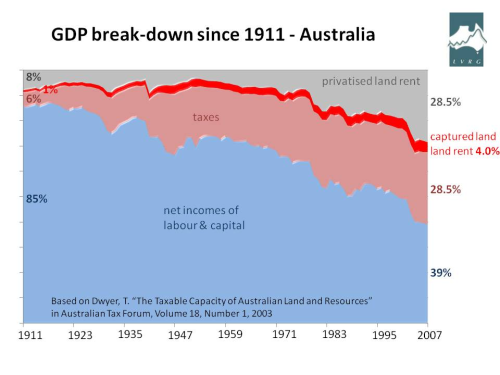We’re having this global financial crisis because we got our economics wrong. We reached the point where we came to believe that most of us could live off dividends, rents and capital gains. Once we started shifting too many billions of dollars around in this misbegotten belief, the wheels were always going to fall off, as I had forecast (PDF 136KB) in a British journal in 2001.
A nation may elect to serve as a service sector for others and have little or no manufacturing sector, but all countries can’t aspire to specialise only in finance, insurance and real estate - the “FIRE” sector. The collapses in the United States and Britain have demonstrated that we need more than the FIRE sector and government if we are to generate real wealth, security and prosperity. Germany provides an anti-speculative model, but its exports will be hit as the world’s other economies decline.
Manufacturing that hasn’t been driven offshore already in much of the West (to where taxation, land and wages are cheaper) is handicapped to the point you’d swear it’s a crime for people to be productive. We tax people who are doers, yet reward parasites who live off the citizens’ rent. People aren’t stupid. They read these fiscal signals and behave accordingly, setting their caps for real estate rent-seeking. We need to change the signals if the economy is to be resurrected.
Advertisement

Since 1911, Australian after-tax incomes of labour and capital have declined relentlessly towards vanishing point, from 85 per cent of GDP to only 39 per cent, as tax revenues have grown to occupy 32.5 per cent of the economy. Coincidentally, land rent has also grown to 32.5 per cent of GDP. As we capture only 4 per cent of GDP through rates, land taxes and other taxes on immovable property, this means that privatised land rent now represents an enormous 28.5 per cent of our GDP! We’ve developed an unsustainable economy of “the free ride”.
Sure, the wealthy pay more taxes than most of us, but as they own more properties (and the most valuable), they’ve been able to claw back each and every red cent of what they’ve paid in taxation over the years through increases in the value of their real estate assets. The middle class and renters don’t have this privilege; hence, the widening rich-poor gap that has been permitted to develop over the last 35 years of “economic rationalism”.
So, what on earth has any of this got to do with having a roof over our heads?
Just this: as land rent is privately captured, it becomes capitalised into escalating land prices. While the land component was some 25 per cent of the purchase price of the average home in Australia in 1972, by 2009 it had reached slightly beyond 70 per cent. This has little to do with population growth, as the following analysis demonstrates.
ABS Catalogue 5205 (Table 61) tells us that total land prices in Australia reached $3.147 trillion in 2008. Total land prices to GDP has averaged 1.1 since 1911, but the ratio currently stands at 2.74 times GDP. Doesn’t this suggest an enormous land price bubble has developed? Maybe, as our real estate spruikers tell us, we have established a new, permanent plateau from which we will continue to launch ourselves ever upwards, but the collapse in real estate around the world can hardly make us sanguine of this possibility?
Advertisement

We’ve got a double standard on rocketing land prices that needs addressing. We get a warm inner glow when the value of our property rises, but then cry crocodile tears about how our kids are ever going to be able to afford a roof over their heads. No inquiry into housing affordability has ever tried to solve this conundrum honestly. Why not? Vested interests maybe? John Locke put it very well in a letter addressed to Alexander Small on September 28, 1787:
Our Legislators are all Landholders; and they are not yet persuaded that all Taxes are finally paid by the Land ... and therefore we have been forc'd into the Mode of indirect Taxes ...
Discuss in our Forums
See what other readers are saying about this article!
Click here to read & post comments.
42 posts so far.